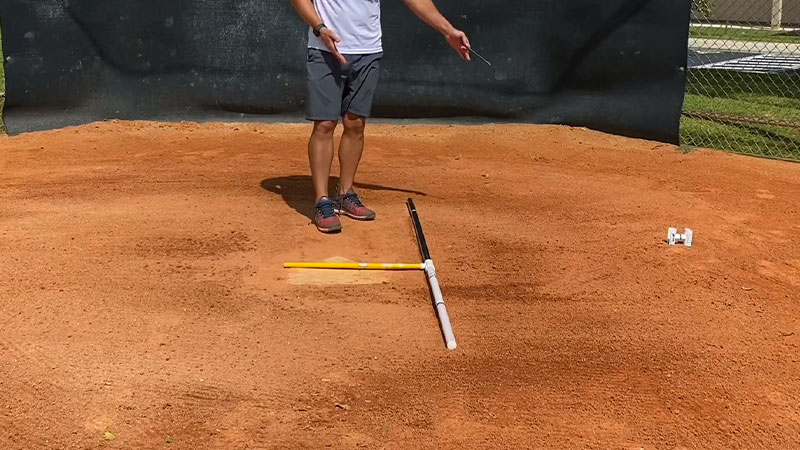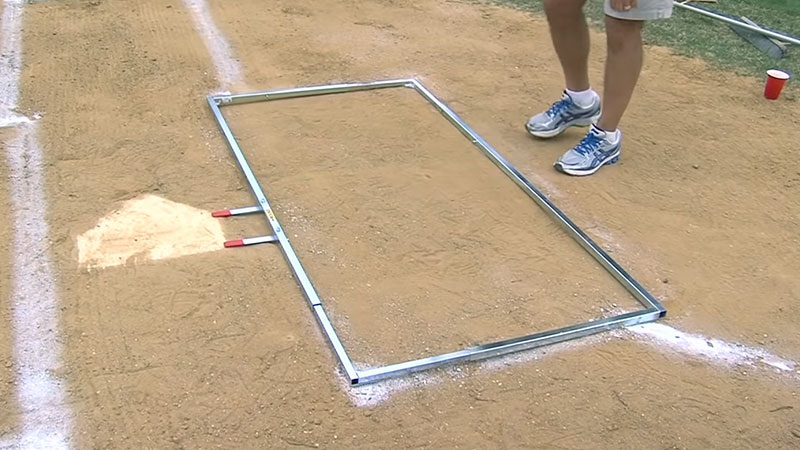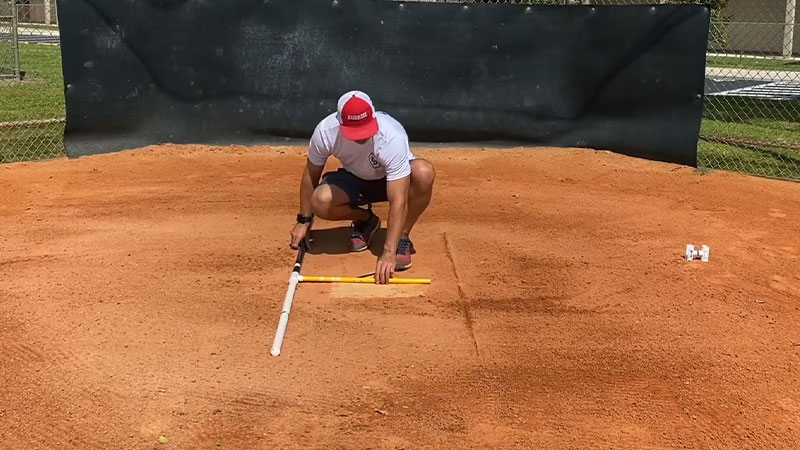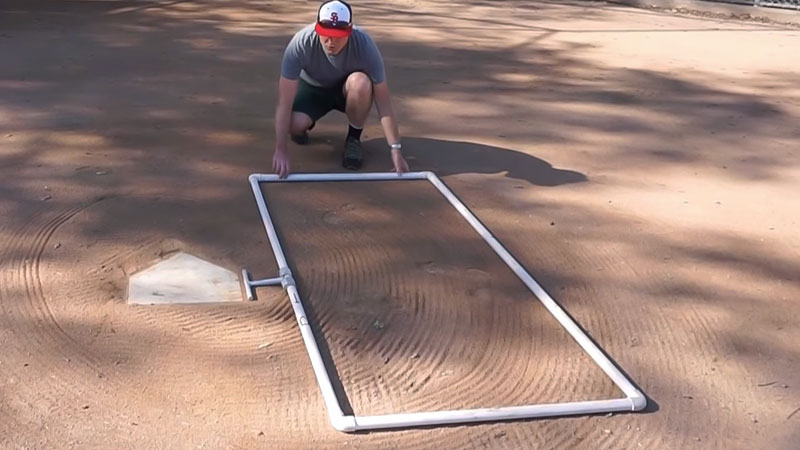Making a batter’s box template out of PVC is a straightforward process that provides a durable and customizable solution for maintaining consistent playing conditions in baseball or softball.
PVC, known for its versatility and affordability, offers an excellent material for constructing a batter’s box template that meets your needs.
In this guide, we’ll walk you through the step-by-step process of creating your own PVC batter’s box template, from gathering materials to assembling the frame.
Whether you’re a coach looking to improve practice sessions or a player wanting to enhance backyard drills, a PVC batter’s box template offers convenience and flexibility.
Following the instructions outlined here, you can construct a professional-looking template that adheres to the regulations and dimensions of your sport, providing a level playing field for all participants. So, stay focused.
Can I Make a DIY Batters Box Template At Home?

You can create a DIY batter’s box template at home using materials like plywood, cardboard, or even masking tape.
The key is to ensure that the dimensions of the batter’s box comply with the regulations of the sport you’re playing, such as baseball or softball.
This typically involves measuring and marking the appropriate dimensions for the batter’s box, including the width, length, and distance from the home plate.
Once you have the dimensions marked out, you can use a utility knife or saw to cut out the shape of the batter’s box from the material you’re using.
If you’re using masking tape, you can lay it down on the ground to create the lines of the batter’s box.
Tools Needed to Make PVC Batters Box Template DIY

To make a PVC baseball batter box template DIY, you will need the following tools:
- PVC Pipes: These will serve as the primary material for constructing the template. You’ll need pipes of appropriate length and diameter according to your desired dimensions for the batter’s box.
- PVC Pipe Cutter or Hacksaw: You’ll need a tool to cut the PVC pipes to the desired lengths. A PVC pipe cutter is ideal for clean, precise cuts, but a hacksaw can also be used if you don’t have a pipe cutter.
- PVC Connectors: Depending on your design, you may need various types of PVC connectors, such as elbows, tees, and couplings, to join the pipes together and create the desired shape for the batter’s box.
- Measuring Tape: This will measure the dimensions of the batter’s box and ensure accuracy while cutting the PVC pipes.
- Marker: Based on your measurements, you’ll need a marker to mark the cutting points on the PVC pipes.
Optional: PVC cement or adhesive may secure the connections between the PVC pipes and connectors for added stability, though this is not always necessary.
How To Make A Batters Box Template Out Of PVC: Step-by-Step Instruction
Sure, here’s a step-by-step guide on how to make a batter’s box template out of PVC:
Gather Materials
Collect all the necessary materials, including PVC pipes, PVC connectors, a PVC pipe cutter or hacksaw, measuring tape, marker, and optional PVC cement or adhesive.
Measure and Mark
Use the measuring tape and marker to measure and mark the dimensions of the batter’s box on the PVC pipes. A batter’s box is typically a rectangle measuring 4 feet wide by 6 feet deep. Make sure to mark the cutting points accurately.
Cut the PVC Pipes
Use the PVC pipe cutter or hacksaw to cut the PVC pipes according to the measurements and marks you made in the previous step. Take care to make clean, straight cuts for a neat finish.
Assemble the Frame
Begin assembling the PVC frame by connecting the cut pipes with the appropriate PVC connectors. Use elbows for corners and tees for intersections, as needed. Make sure the frame is sturdy and square.
Optional Secure Connections
If desired, apply PVC cement or adhesive to the connections between the PVC pipes and connectors to ensure they are securely bonded. Follow the manufacturer’s instructions for the adhesive you’re using.
Final Touches
Once the frame is assembled and any adhesive has dried, place the PVC batter box template in the desired location on the ground. It’s now ready to be used for practice or games.
By following these steps, you can create a durable and portable batter’s box template out of PVC to help maintain consistent playing conditions on the field.
Can I Make a Softball Batters Box Template at Home?

Yes, you can make a softball batter’s box template at home to ensure accurate and consistent playing conditions on the field.
Creating your own batter’s box template can be a cost-effective solution and allows you to customize it to fit your specific needs. Here are some steps to guide you through the process:
Gather Materials
Start by gathering the necessary materials for your batter’s box template. Depending on your preferred construction method, you will need materials such as plywood, PVC pipes, cardboard, or masking tape.
Determine Dimensions
Softball batter’s boxes typically measure 7 feet by 3 feet, with the front edge of the box positioned 4 feet from the back tip of the home plate. Measure and mark these dimensions accurately on your chosen material.
Cut the Material
Use a saw or utility knife to cut the material to the desired dimensions for the batter’s box template. Take care to make straight and precise cuts to ensure a professional-looking result.
Create Markings
If using plywood or cardboard, use paint or markers to create the lines and markings of the batter’s box template.
Alternatively, if using PVC pipes or masking tape, lay them down on the ground according to the marked dimensions to form the lines of the batter’s box.
Secure in Place
Once the markings are complete, secure the batter’s box template in place on the field using stakes, weights, or adhesive, depending on the material you’ve chosen.
This will prevent it from shifting during use and maintain its position on the field.
Regular Maintenance
Over time, the batter’s box template may experience wear and tear from repeated use.
Check it regularly for any damage or fading and make necessary repairs or touch-ups to ensure it remains in good condition for continued use.
By following these steps, you can create a home softball batter’s box template that meets the dimensions and specifications required for consistent and fair play on the field.
Is the Little League Batters Box Template Different?
Yes, the Little League batter’s box template does differ slightly from the standard softball or baseball batter’s box used in higher-level play.
Little League regulations typically have specific dimensions for the batter’s box that are tailored to accommodate younger players and ensure a safe and fair playing environment.
Here’s a detailed explanation of how the Little League batters box template differs and why:
Size
One key difference in the Little League batters box template is its size. The batter’s box’s dimensions are typically smaller than those used in adult or higher-level play.
Little League regulations often specify a narrower width and shorter length for the batter’s box to suit the smaller stature of youth players.
For example, a typical Little League softball batter’s box may measure around 3 feet wide by 6 feet deep, whereas the dimensions for adult softball may be slightly larger.
Safety Considerations
Another factor that influences the design of the Little League batters box template is safety. Youth players have different skill levels and may not possess the same level of control over their swings as older, more experienced players.
Therefore, the smaller dimensions of the batter’s box help reduce the distance between the batter and the pitcher, minimizing the risk of wild pitches or errant swings that could potentially cause injury.
Fairness and Development
Little League aims to provide a level playing field for all players and promote skill development in a supportive environment.
By using a batters box template tailored to the needs of youth players, Little League ensures that batters have an appropriate area to stand and swing the bat, regardless of their age or skill level.
This helps create a fair and enjoyable experience for everyone involved in the game.
Compliance with Regulations
Little League batter’s box dimensions are governed by specific regulations set forth by the organization.
These regulations are designed to uphold the principles of safety, fairness, and player development that are central to the mission of Little League.
By adhering to these regulations, leagues, and teams can ensure consistency and standardization across games and tournaments.
Adaptability
While the dimensions of the Little League batters box template are standardized, some flexibility may be allowed depending on factors such as field conditions or league preferences.
However, any modifications must still adhere to the basic principles of safety and fairness outlined by Little League regulations.
The Little League batters box template differs from the standard template used in higher-level play regarding size, safety considerations, fairness, compliance with regulations, and adaptability.
FAQs
What materials do I need to make a batter’s box template out of PVC?
You’ll need PVC pipes, connectors (like elbows and tees), a PVC pipe cutter or hacksaw, measuring tape, a marker, and optional PVC cement for added stability.
What are the dimensions of a standard PVC batter’s box template?
A standard PVC batter’s box template typically measures 4 feet wide by 6 feet deep, mirroring the dimensions of a traditional batter’s box used in baseball or softball.
Can I customize the size of the PVC batter’s box template?
Yes, you can customize the dimensions of the PVC batter’s box template to suit your specific needs or preferences. However, ensure that it adheres to the regulations and standards of the sport you’re playing.
How do I secure the PVC pipes and connectors together?
Use PVC cement or adhesive to secure the connections between the PVC pipes and connectors for added stability.
Apply the adhesive according to the manufacturer’s instructions, and allow sufficient time for it to dry before using the batter’s box template.
Can I use the PVC batter’s box template on different surfaces?
Yes, the PVC batter’s box template is versatile and can be used on various surfaces, including grass, dirt, or turf.
Ensure the surface is flat and level before placing the template to maintain consistency in the batter’s box dimensions.
Wrapping Up
Creating a batter’s box template out of PVC is a practical and customizable solution for maintaining consistent playing conditions in baseball or softball.
Following the steps outlined in this guide and using the right materials and tools, you can easily construct a durable and portable template that meets your needs.
Whether for Little League games or backyard practice sessions, a PVC batter’s box template offers versatility and convenience.
Remember to adhere to the regulations and dimensions of the sport you’re playing, and consider adding PVC cement for added stability.
With a PVC batter’s box template, you can enhance the playing experience for yourself, your team, or your league while ensuring a level playing field for all players. Stay focused.







